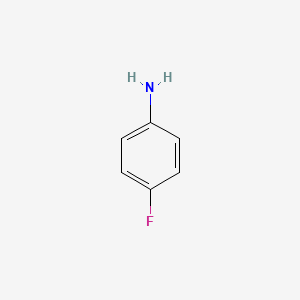



1. 4-fluoroaniline Hydrochloride
1. 371-40-4
2. P-fluoroaniline
3. 4-fluorobenzenamine
4. 1-amino-4-fluorobenzene
5. Benzenamine, 4-fluoro-
6. P-fluorophenylamine
7. 4-fluoronaniline
8. Para-fluoroaniline
9. Aniline, P-fluoro-
10. 4-fluoro-phenylamine
11. Aniline, 4-fluoro-
12. 4-fluoranilin
13. 4-fluorophenylamine
14. Nsc 579
15. Mfcd00007829
16. P-aminofluorobenzene
17. 4-fluorobenzenaminium
18. Chebi:28546
19. (4-fluorophenyl)-amine
20. Chembl32014
21. Dtxsid9022027
22. Nsc-579
23. 60hi1g076z
24. 4-fluoranilin [czech]
25. Fluoroaniline, P-
26. Ccris 5059
27. Hsdb 2691
28. Einecs 206-735-5
29. Brn 0742030
30. 4flouroaniline
31. P-fluoraniline
32. Unii-60hi1g076z
33. 4-flouroaniline
34. 4-floroaniline
35. 4-fluoroanilin
36. 4-fluroaniline
37. Ai3-52386
38. P-fluoro-aniline
39. 4 -fluoroaniline
40. 4- Fluoroaniline
41. 4-fluoro Aniline
42. 4-fluoro-aniline
43. 4-fluoranylaniline
44. 4-fluorobenzeneamine
45. (4-fluorophenyl)amine
46. 1,4-fluorobenzenamine
47. 4-fluoro-1-aminobenzene
48. 4-fluoroaniline, 99%
49. Dsstox_cid_2027
50. Wln: Zr Df
51. Ec 206-735-5
52. Schembl3199
53. Dsstox_rid_76464
54. Dsstox_gsid_22027
55. 4-12-00-01104 (beilstein Handbook Reference)
56. 4-fluoroaniline [mi]
57. Nsc579
58. 4-fluoroaniline [hsdb]
59. Zinc13613
60. Act00169
61. Bcp21217
62. Tox21_202828
63. Bdbm50282614
64. Stl168895
65. Akos000119114
66. Am61493
67. Ps-9263
68. Un 2944
69. Ncgc00260374-01
70. Cas-371-40-4
71. Db-023950
72. F0033
73. Ft-0618502
74. 4-fluoroaniline, Technical, >=97.0% (gc)
75. D78529
76. A823539
77. J-515394
78. P-fluoroaniline [un2941] [keep Away From Food]
79. Q27103764
80. Z57127563
81. F2190-0427
| Molecular Weight | 111.12 g/mol |
|---|---|
| Molecular Formula | C6H6FN |
| XLogP3 | 1.1 |
| Hydrogen Bond Donor Count | 1 |
| Hydrogen Bond Acceptor Count | 2 |
| Rotatable Bond Count | 0 |
| Exact Mass | 111.048427358 g/mol |
| Monoisotopic Mass | 111.048427358 g/mol |
| Topological Polar Surface Area | 26 Ų |
| Heavy Atom Count | 8 |
| Formal Charge | 0 |
| Complexity | 66.9 |
| Isotope Atom Count | 0 |
| Defined Atom Stereocenter Count | 0 |
| Undefined Atom Stereocenter Count | 0 |
| Defined Bond Stereocenter Count | 0 |
| Undefined Bond Stereocenter Count | 0 |
| Covalently Bonded Unit Count | 1 |
The in vitro hydroxylation-defluorination of p-fluoroaniline was carried out by liver microsomes from the rabbit, rat, sheep, cow, pig, man and pigeon, but not by microsomes prepared from trout.
PMID:5646022 Renson J, Bourdon V; Arch Int Pharmacodyn Ther 171 (1): 240 (1968)
p-Fluoroaniline is defluorinated notably in vivo in rats, clearly evidenced by the increase in urinary fluoride.
Truhaut R et al; J Eur Toxicol 5 (3): 155 (1972)
Possible methods for monitoring exposure to 2,4-difluoroaniline and 4-fluoroaniline were studied in rats. Wistar rats were given 1.0, 0.25, and 0.13 millimoles per 0.1 kilogram 2,4-difluoroaniline or 4-fluoroaniline. Blood samples were taken at 1 hr before and 1, 2, 4, 6, 8, and 24 hr after dosing. Methemoglobin was calculated from absorbance at 630 nm before and after adding potassium cyanide to lysed blood. Urinary metabolites were isolated as cetylpyridinium salts from rats similarily dosed with 4-fluoroaniline and 2,4,-difluoroaniline. Analysis of urinary metabolites confirmed that these were the o-sulfates of 2-amino-5-aminophenol and 2-amino-3,5-difluorophenol. The excretion of the urinary conjugated aminophenols after oral dosing with these cmpd was rapid and only low concentrations were detected the second day after dosing. About 39% of 4-fluoroanilne and 13% of 2,4-difluoroaniline were accounted by these metabolites.
PMID:6490181 Eadsforth CV et al; Int Arch Occup Environ Health 54 (3): 223-32 (1984)
The regioselectivity and metabolism of monofluoroanilines were studied in-vivo and in-vitro. Male Wistar-rats were administered 0 or 50 mg/kg 2-fluoroaniline, 3-fluoroaniline, or 4-fluoroaniline orally. Urine samples were collected 24 hours later and analyzed for metabolites by fluorine-19 nuclear magnetic resonance spectroscopy. Liver microsomes prepared from male Wistar-rats that had been pretreated with the cytochrome-P-450 (P450) inducers were fortified with P450 and incubated with 0 or 10 millimolar 2-fluoroaniline, 3-fluoroaniline, or 4-fluoroaniline for 10 minutes. The incubates were analyzed for metabolites. Frontier electron densities of occupied and unoccupied orbitals of 2-fluoroaniline, 3-fluoroaniline, and 4-fluoroaniline were calculated by a computerized semiempirical molecular orbital technique. 3-Fluoro-4-acetamidophenylsulfate, 3-fluoro-4-aminophenylsulfate, and 3-fluoro-4-acetamidophenylglucuronide were the major 2-fluoroaniline urinary metabolites. 2-Fluoro-4-acetamidophenylsulfate, 4-fluoro-2-aminophenylsulfate, 2-fluoro-4-aminophenylsulfate, and the fluoride-ion (F-) were the major metabolites of 3-fluoroaniline. 5-Fluoro-2-aminophenylsulfate and fluoride-ion were the major metabolites of 4-fluoroaniline. In-vitro, 3-fluoro-4-aminophenol was the major 2-fluoroaniline metabolite. 3-Fluoroaniline was converted primarily to 4-aminophenol and 4-fluoro-2-aminophenol. 4-Fluoroaniline was converted primarily to 5-fluoro-2-aminophenol and F-. In microsomes from rats pretreated with the P450 inducers, 3-fluoroaniline underwent hydroxylation primarily in the para position, the extent of hydroxylation being similar for all pretreatment conditions. Ortho hydroxylation at the C6 position occurred under all pretreatment conditions but to a much smaller extent. Ortho hydroxylation at the C2 position occurred only in microsomes from rats pretreated with 3MC and isosafrole. Frontier electron densities in the highest occupied molecular orbital (HOMO) and the orbital just below it (HOMO-1) were highest in the C4 position followed by the C6 and C2 positions. /The investigators/ conclude that the regioselectivity in the hydroxylation of 3-fluoroaniline can be explained by higher electron densities in the HOMO and HOMO-1 orbitals of the C4 and C6 carbons and the low density at the C2 position. P450 catalyzed hydroxylation of monofluoroanilines apparently involves electrophilic attack of a charged iron/oxygen species derived from P450 on a specific carbon atom of the aromatic ring.
Cnubben NHP et al; Chemico-Biological Interactions 85 (2/3): 151-172 (1992)
For more Metabolism/Metabolites (Complete) data for 4-FLUOROANILINE (6 total), please visit the HSDB record page.